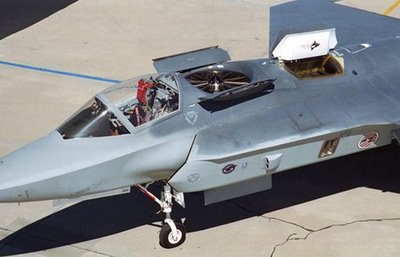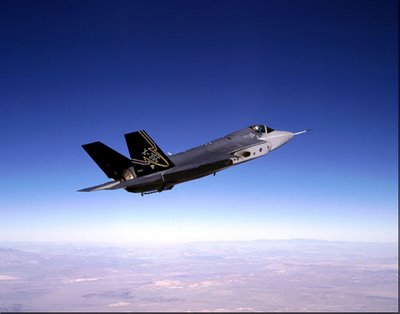X-35
 X-35, Nice but will it arrive too late?
X-35, Nice but will it arrive too late? Australia has all 10 toes & 10 fingers in the X-35 pie. But 2014 is way too long a wait. It will replace the aging but cool F111.
Australia has all 10 toes & 10 fingers in the X-35 pie. But 2014 is way too long a wait. It will replace the aging but cool F111.X-35
DESCRIPTION: As part of the Joint Strike Fighter project, Lockheed Martin was funded to build the X-35 demonstrator to compete against the Boeing X-32. The winner of this competition would receive a major contract to develop a production fighter for the US Air Force, US Navy, US Marine Corps, and UK Royal Navy.
DESCRIPTION: As part of the Joint Strike Fighter project, Lockheed Martin was funded to build the X-35 demonstrator to compete against the Boeing X-32. The winner of this competition would receive a major contract to develop a production fighter for the US Air Force, US Navy, US Marine Corps, and UK Royal Navy.
Lockheed was joined by partners Northrop Grumman and British Aerospace in developing an aircraft resembling the larger F-22. The X-35 was powered by an advanced engine derived from that used on the F-22 and fed by two side intakes mounted beneath swept wings.
To meet the needs of the various services, three variants of the X-35 were designed and test flown between 2000 and 2001. The conventional takeoff and landing (CTOL) X-35A was developed for the US Air Force, the short takeoff and vertical landing (STOVL) X-35B for the US Marines and UK Royal Navy, and the carrier-based (CV) X-35C for the US Navy.
However, Lockheed was actually only funded to construct two prototypes for evaluation. The X-35A, first to be completed, was used for early flights before being modified and fitted with a second engine. This additional engine, a shaft-driven lift-fan system plus roll control jets along the wings, was coupled to the primary engine to provide the lift for vertical flight.
This modified airframe was redesignated the X-35B for completion of the STOVL portion of the evaluation process.
During the three-month conversion process, test flight duties were assumed by the X-35C demonstrator for the Navy. This model featured an enlarged wing of greater span and area for larger fuel capacity. The X-35C was also equipped with enlarged horizontal tails and flaperons for greater control effectiveness during low-speed carrier approaches.
Once the conversion of the X-35A to the X-35B was complete, Lockheed proceeded with the most challenging portion of the flight test demonstration effort. The use of two separate engines to meet the vertical flight requirement was inspired by the Russian Yak-141. The additional lift fan fitted to the X-35B was powered by the F119 engine but provided an independent source of thrust in hover mode.
While the hover method adopted by Boeing in the X-32 was considered more conventional, Lockheed argued that the lift fan approach offered more room for growth in aircraft's future design evolution.
The US military appeared to agree with Lockheed Martin's argument in October 2001 when the company was selected to proceed with the development of a production F-35 fighter.


<< Home